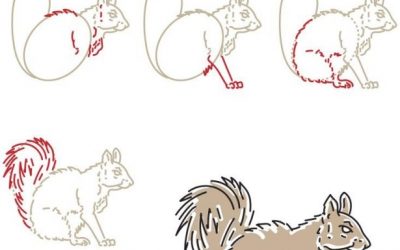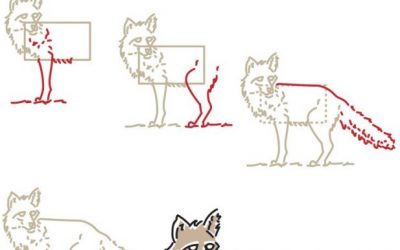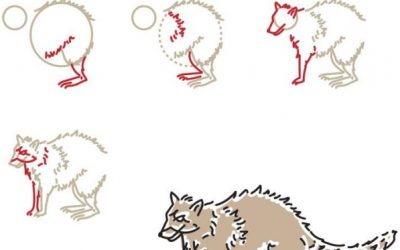
MATERIALS
• Cartridge paper for sketching.
• HB, 2B and 4B pencils.
• Gum Strip tape.
• Lightweight marine ply board.
• Containers of water.
• Masking fluid.
• Half sheet of Saunders Waterford watercolour paper – 200gsm rough surface.
• Winsor & Newton artists’ quality watercolours: Prussian Blue; Cobalt Blue; French Ultramarine Blue; Lemon Yellow; Naples Yellow; Cadmium Orange; Burnt Umber; Burnt Sienna; Alizarin Crimson; Permanent Rose; Chinese White.
• Brushes: Numbers 24,12, 7, 5, 2 and 0.
STEP ONE
I search for an interesting subject in my garden. The little Superb Blue Wrens are very busy – so I include the male blue wren in my composition and (for interest) add my teacup. This is a tonal sketch done with 2B and 4B pencil. I am hoping to create a feeling of a fleeting moment when Nature and man-made objects meet. I concentrate on placing the darks and the lights where they are needed to throw the subject matter forward and recess less important areas of the composition.

STEP TWO
Having stretched a half sheet of paper the night before on my board, I draw the outline of my composition onto it with a HB pencil. I then refer back to my early sketch and, using masking fluid, apply this to areas that I wish to keep free of background colour; or where I want to create white areas. I always use the same brush (preferably not an expensive one) for applying masking fluid – as it tends to separate the hairs over time, even when regularly washed out with warm soapy water.

STEP THREE
Time to start painting. I apply the background washes which I allow to mix together on the paper for greater intensity of colour. These are watery mixtures of Cobalt Blue, Alizarin Crimson, Lemon Yellow, Naples Yellow and French Ultramarine Blue. I decide to float a very light wash of Chinese White in the top left corner to bring relief to a large area of Cobalt Blue. Nice results are achieved when using these wet-on-wet techniques. Once the paper is dry, I remove the masking fluid and, using Burnt Umber and Burnt Sienna, lightly add in the tree branches and garden seat slats. I then work the cast iron sides of the seat with a wash of Prussian Blue; dropping in the Burnt Sienna for rusty areas.

STEP FOUR
Here, I concentrate on all the white papered areas except the wren and the teacup and saucer (which I leave until last). I use stronger mixes of Naples Yellow, Lemon Yellow and Cobalt Blue to produce light green foliage – especially for the leaves of the Vincas poking up through the seat. I add Permanent Rose to the petals Alizarin Crimson to the centres and Raw Sienna to the stems. I also work in more detail on the cast iron, using Prussion Blue. In the background, the foliage colours are applied more loosely so they don’t overpower the foreground images. These are all wet-ondry applications of the paint.

STEP FIVE
I apply myself to the finer details of our feathered friend and my teacup. I use Cobalt Blue; a dark mix of Prussian Blue, Alizarin Crimson and a little Naples Yellow to produce a black; and Burnt Umber – for the feathers and legs. I do the black eye last. The teacup is glazed with a pale Naples Yellow wash, and then the pattern and shadows are applied in French Ultramarine Blue. Small dabs of Cadmium Orange are put in; and throughout the picture I leave areas of white paper free of paint … these help to create a ‘sparkle in my work and give it freshness.

FINAL STEP
This is the point when I stand back from my work and takes notes of where and what the finishing touches are to be. Using the colours from my palette, I deepen certain areas and put in the shadows while still trying to keep the work crisp. Small details such as light on the wren’s feathers, beak and toenails are enhanced using a little Chinese White. Originally, my teacup did not have tea in it – but after close scrutiny I decide to top it up, using Naples Yellow and Burnt Sienna. I place a cut-out mat to surround my work, and I sign it. Then it’s off to be framed.

MASTER HINT’S AND TIPS
• Stepping outside your studio and looking at the world around you is often where you will find the greatest source of artistic inspiration. Lots of quick little sketches – no matter how insignificant they may seem – are great building blocks for larger ideas and final compositions.
• Once I have a clear image in my mind and a tonal sketch on paper, the confidence to paint comes easily.
• Take the telephone off the hook when doing wet-on-wet areas such as large background washes.
• Having chosen and laid out the colours you wish to paint with, do a small rough painting of your idea. This, together with your tonal sketch, can help as a ‘memory bank’ for your final painting.
• Keep at least three jars of water beside you, and use one of these purely for rinsing out your brushes. Your other jars will be suitable for adding clean water to your paints. Regularly change the water and keep your palette clean.





